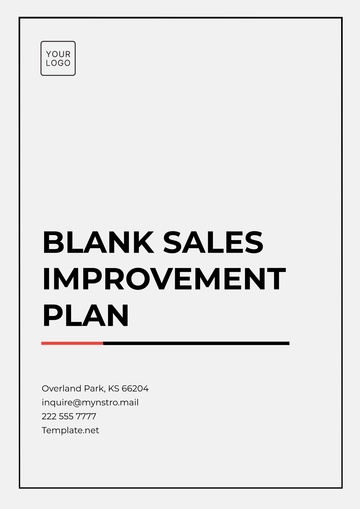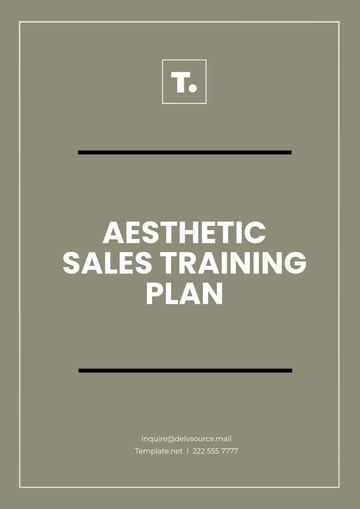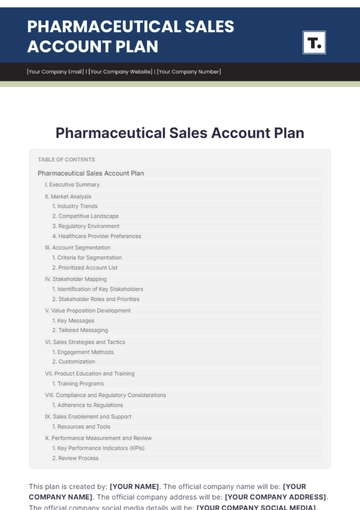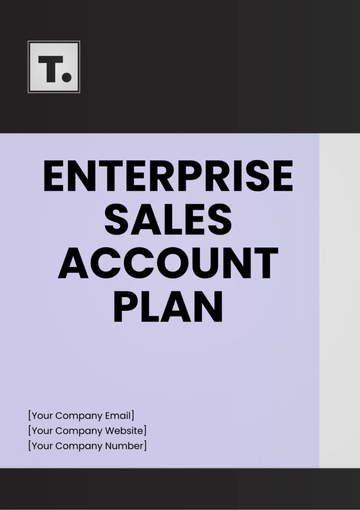Free Sample Hotel Sales Plan

I. Executive Summary
The [Your Company Name] Sales Plan for [2050] outlines our strategic approach to achieving a [15]% increase in revenue and a [10]% improvement in occupancy rates. Our primary objectives are to expand our market share within the corporate and leisure travel segments, enhance our online presence, and improve guest satisfaction scores. We aim to achieve these goals by leveraging data analytics to understand guest preferences, implementing personalized experiences, and strengthening our loyalty program to encourage repeat business.
To support these objectives, we will deploy targeted marketing campaigns, form strategic partnerships with local businesses and travel agencies, and enhance our digital marketing efforts through social media, SEO, and email campaigns. Additionally, we will focus on optimizing our sales team structure to improve efficiency and accountability. By aligning our sales and marketing strategies with these comprehensive initiatives, [Your Company Name] aims to establish itself as the premier choice for both business and leisure travelers in the region, ensuring sustained growth and profitability in the competitive hospitality market.
II. Market Analysis
Understanding the hotel's target market is crucial for developing effective sales strategies. By analyzing the demographics, trends, and competitors, [Your Company Name] can better tailor its offerings to meet the needs of potential guests. The table below presents a comprehensive market analysis, highlighting key segments, demographic characteristics, prevailing market trends, and an overview of our main competitors. This analysis will inform our marketing efforts and ensure that we effectively position ourselves within the market to maximize occupancy and revenue.
Market Segment | Demographics | Trends | Competitors |
|---|---|---|---|
Corporate Travelers | Age: 30-55 Gender: Male and Female Income: High | Increase in business travel post-pandemic Preference for high-speed internet and business amenities | [Competitor A] [Competitor B] |
Leisure Travelers | Age: 25-65 Gender: Male and Female Income: Middle to High | Growth in eco-tourism Demand for unique, local experiences | [Competitor C] [Competitor D] |
Families | Age: 35-50 (parents) Gender: Male and Female Income: Middle | Preference for family-friendly amenities Increase in multi-generational travel | [Competitor E] [Competitor F] |
Event Attendees | Age: 25-60 Gender: Male and Female Income: Middle to High | Rise in hybrid events Demand for flexible event spaces | [Competitor G] [Competitor H] |
III. Sales Objectives
The sales objectives for [Your Company Name] in [2050] are designed to drive significant growth and enhance our competitive position in the hospitality market. These objectives are clear, measurable, and focused on key performance indicators that reflect our commitment to excellence and customer satisfaction.
Revenue Growth: Achieve a [15]% increase in total revenue compared to the previous fiscal year. This will be accomplished through a combination of enhanced marketing efforts, strategic partnerships, and the introduction of new service offerings that appeal to our target market segments.
Occupancy Rates: Improve occupancy rates by [10]%, reaching an average annual occupancy rate of [85]%. This will involve targeted promotions during off-peak periods, improved guest retention strategies, and dynamic pricing models to optimize room sales.
Market Share Expansion: Increase our market share in both the corporate and leisure travel segments by [8]%. We will focus on capturing a larger share of the corporate travel market through tailored business packages and by enhancing our meeting and event facilities. For leisure travelers, we will emphasize unique experiences and local attractions.
Guest Satisfaction: Enhance guest satisfaction scores to exceed industry benchmarks, aiming for a satisfaction rate of [95]%. This will be achieved by implementing personalized guest experiences, upgrading amenities, and providing exceptional customer service.
IV. Sales Strategies
To achieve our ambitious sales objectives, [Your Company Name] will implement a comprehensive set of strategies focused on pricing, promotions, and distribution channels. These strategies are designed to optimize revenue, enhance occupancy rates, and increase market share across both corporate and leisure segments.
A. Pricing Strategies
Implementing effective pricing strategies is critical to maximizing revenue while maintaining competitive occupancy rates:
Dynamic Pricing: Utilize advanced analytics and market data to implement dynamic pricing models. This approach will allow us to adjust room rates based on demand, seasonality, and competitor pricing, maximizing revenue without compromising occupancy rates.
Corporate Rate Packages: Develop competitive corporate rate packages that offer value-added services such as complimentary Wi-Fi, breakfast, and access to business centers. These packages will be tailored to meet the needs of corporate travelers and event planners.
Loyalty Discounts: Offer exclusive discounts and benefits to members of our loyalty program. This will incentivize repeat business and encourage guests to book directly through our website.
B. Promotional Strategies
Strategic promotions are essential for driving bookings and increasing brand awareness. The strategies below can effectively target both corporate and leisure travelers, ensuring a consistent flow of guests throughout the year:
Seasonal Promotions: Launch targeted promotions during off-peak seasons to boost occupancy rates. These promotions will include special rates, bundled packages, and exclusive experiences that appeal to both corporate and leisure travelers.
Social Media Campaigns: Leverage social media platforms to engage with potential guests, promote special offers, and showcase unique aspects of our hotel. This will help build brand awareness and drive direct bookings.
Event Partnerships: Collaborate with local event organizers to offer special rates for attendees. This will position our hotel as the preferred accommodation choice for conferences, weddings, and other events.
C. Distribution Channels
Enhancements of distribution channels will ensure [Your Company Name] maximizes visibility and attracts a wide range of guests, from individual travelers to large corporate groups:
Direct Booking Enhancements: Enhance our website and mobile app to provide a seamless booking experience. This will include user-friendly navigation, secure payment options, and personalized recommendations based on guest preferences.
Online Travel Agencies (OTAs): Maintain strong relationships with OTAs to ensure our hotel is prominently featured. We will negotiate favorable commission rates and participate in OTA-led promotions to increase visibility and bookings.
Corporate Partnerships: Establish partnerships with local businesses and multinational corporations to secure corporate contracts and bulk bookings. This will involve offering tailored packages and competitive rates for long-term stays.
D. Guest Experience Enhancement
Enhancing the guest experience is crucial for boosting satisfaction and encouraging repeat business:
Personalized Services: Implement data-driven personalization to offer tailored services and amenities based on guest preferences. This includes room customization options, personalized welcome amenities, and targeted upselling of hotel services.
Feedback Mechanism: Develop a robust feedback system to gather and analyze guest feedback. This will help identify areas for improvement and ensure continuous enhancement of the guest experience.
V. Marketing Plan
To effectively market [Your Company Name] to our target audience, we will implement a multi-faceted marketing plan that combines traditional advertising, innovative promotions, and robust digital marketing strategies. This comprehensive approach will ensure we reach a broad audience, enhance our brand presence, and drive bookings across all market segments.
A. Advertising
Utilize print media and outdoor advertising to increase visibility among business and leisure travelers. Strategic ad placements in high-traffic areas and leading publications will highlight our hotel's unique features and special offers, effectively capturing the interest of potential guests.
Print Media: Place ads in leading travel magazines, local newspapers, and industry publications to reach both business and leisure travelers. Highlight unique features, special offers, and upcoming events to capture the interest of potential guests.
Outdoor Advertising: Utilize billboards and transit advertising in high-traffic areas to increase visibility. Focus on strategic locations such as airports, business districts, and popular tourist attractions.
B. Promotions
Implement seasonal campaigns, event-based promotions, and loyalty program initiatives to drive bookings. These promotions will attract guests during off-peak periods, encourage attendance at local events, and incentivize repeat bookings through exclusive offers for loyalty program members.
Seasonal Campaigns: Launch seasonal promotions to attract guests during off-peak periods. Examples include winter holiday packages, summer getaway deals, and special offers for long weekends and public holidays.
Event-Based Promotions: Partner with local event organizers to create exclusive packages for attendees of conferences, festivals, and sports events. Offer discounted rates and added-value services to encourage bookings.
Loyalty Program Initiatives: Enhance our loyalty program with additional perks and exclusive promotions for members. Implement targeted campaigns to encourage repeat bookings and direct reservations through our website.
C. Digital Marketing Strategies
Enhance online presence through SEO, social media marketing, email campaigns, PPC advertising, and influencer collaborations. These strategies will improve search engine rankings, engage with potential guests, and drive bookings through targeted and personalized digital outreach.
Search Engine Optimization (SEO): Optimize our website content to improve search engine rankings. Focus on relevant keywords, high-quality content, and technical SEO to attract organic traffic from search engines.
Social Media Marketing: Develop a strong presence on social media platforms such as Facebook, Instagram, and Twitter. Share engaging content, promote special offers, and interact with followers to build a loyal online community.
Email Marketing: Implement targeted email campaigns to reach past guests and potential customers. Personalize emails with tailored offers, updates on hotel amenities, and local event information to drive bookings.
Pay-Per-Click (PPC) Advertising: Invest in PPC campaigns on Google Ads and social media platforms. Use precise targeting to reach specific demographics and retarget website visitors who did not complete a booking.
Influencer Collaborations: Partner with travel bloggers and social media influencers to showcase our hotel. Arrange stays and experiences for influencers to share with their audiences, increasing our reach and credibility.
D. Website and Mobile App Enhancements
Improve user experience and content marketing on our website and mobile app. Focus on easy navigation, fast load times, mobile-friendly design, and engaging content to attract and retain guests, ensuring a seamless and informative booking process.
User Experience (UX) Improvements: Continuously improve the UX of our website and mobile app to ensure a seamless booking process. Focus on ease of navigation, fast load times, and mobile-friendly design.
Content Marketing: Create and share high-quality content, such as blog posts, videos, and virtual tours, to engage visitors and provide valuable information about our hotel and local attractions.
VI. Sales Team Structure
A well-defined sales team structure is essential for executing our sales strategies effectively. By clearly outlining roles, responsibilities, and reporting relationships, we can ensure that each team member is aligned with our sales objectives and can collaborate efficiently.
The following table provides an overview of the [Your Company Name] sales team structure, detailing key positions and their primary duties. This structured approach will enable us to drive sales performance, maintain accountability, and foster a cohesive team environment, ultimately leading to the successful achievement of our sales goals.
Position | Roles and Responsibilities | Reports To |
|---|---|---|
Director of Sales |
| General Manager |
Sales Manager |
| Director of Sales |
Corporate Sales Executive |
| Sales Manager |
Leisure Sales Executive |
| Sales Manager |
Event Sales Coordinator |
| Sales Manager |
Digital Marketing Specialist |
| Sales Manager |
VII. Sales Forecast
To project our expected sales revenue, we have conducted a thorough market analysis and aligned our forecast with our sales objectives and strategies. This forecast anticipates growth based on targeted marketing efforts, strategic partnerships, and optimized pricing models. The line graph below illustrates our expected monthly revenue for the year [2050], reflecting a steady increase in sales as our strategies take effect and market conditions improve.
The line graph represents the expected monthly sales revenue for [Your Company Name] in [2050], demonstrating a consistent upward trend throughout the year. Starting with a projected revenue of $[500,000] in January, the forecast anticipates gradual increases each month, reaching $[775,000] by December. This growth trajectory reflects the effectiveness of our sales strategies, including dynamic pricing, targeted promotions, and enhanced marketing efforts.
The steady increase in revenue underscores our confidence in capturing greater market share, improving occupancy rates, and leveraging our digital marketing initiatives. Seasonal promotions and strategic partnerships also contribute to this positive outlook, ensuring sustained growth and profitability. This forecast aligns with our overall objective to achieve a [15]% revenue increase compared to the previous year.
VIII. Budget
To ensure the successful implementation of our sales plan, it is essential to develop a detailed budget that accounts for all necessary expenses. The budget will encompass various aspects, including marketing strategies, sales promotions, and salaries for our dedicated sales team. By meticulously planning our expenditures, we can optimize resources and achieve our sales targets efficiently. The following table outlines the projected budget for implementing our sales plan, providing a comprehensive overview of anticipated costs and allocations. This strategic approach will enable us to make informed decisions, maximize returns on investment, and ultimately enhance our hotel's sales performance.
Item | Description | Estimated Cost ($) |
|---|---|---|
Marketing Expenses | Advertising, online campaigns, collateral | $[0] |
Sales Promotions | Discounts, special packages, loyalty programs | $[0] |
Sales Team Salaries | Base salaries, commissions, bonuses | $[0] |
Training & Development | Sales training programs, workshops | $[0] |
Travel & Accommodation | Sales team travel for meetings, conferences | $[0] |
Technology & Software | CRM systems, sales tracking software | $[0] |
Miscellaneous Expenses | Contingency fund for unforeseen costs | $[0] |
Total | $[0] |
This Sample Hotel Sales Plan for [Your Company Name] outlines a strategic roadmap for achieving substantial growth in [2050]. By focusing on clear objectives, innovative strategies, and a well-structured sales team, we aim to enhance our market presence and drive revenue. With a commitment to excellence and continuous improvement, we are poised to solidify our position as a leading hotel and ensure sustained success in the competitive hospitality industry.
- 100% Customizable, free editor
- Access 1 Million+ Templates, photo’s & graphics
- Download or share as a template
- Click and replace photos, graphics, text, backgrounds
- Resize, crop, AI write & more
- Access advanced editor
Boost your sales strategy with the Sample Hotel Sales Plan Template from Template.net. This editable and customizable document simplifies creating a detailed sales plan for your hotel. Tailored for the industry, it ensures clarity and professionalism in outlining sales goals, strategies, and tactics. Editable in our Ai Editor Tool for seamless customization to meet your specific sales planning needs.
You may also like
- Finance Plan
- Construction Plan
- Sales Plan
- Development Plan
- Career Plan
- Budget Plan
- HR Plan
- Education Plan
- Transition Plan
- Work Plan
- Training Plan
- Communication Plan
- Operation Plan
- Health And Safety Plan
- Strategy Plan
- Professional Development Plan
- Advertising Plan
- Risk Management Plan
- Restaurant Plan
- School Plan
- Nursing Home Patient Care Plan
- Nursing Care Plan
- Plan Event
- Startup Plan
- Social Media Plan
- Staffing Plan
- Annual Plan
- Content Plan
- Payment Plan
- Implementation Plan
- Hotel Plan
- Workout Plan
- Accounting Plan
- Campaign Plan
- Essay Plan
- 30 60 90 Day Plan
- Research Plan
- Recruitment Plan
- 90 Day Plan
- Quarterly Plan
- Emergency Plan
- 5 Year Plan
- Gym Plan
- Personal Plan
- IT and Software Plan
- Treatment Plan
- Real Estate Plan
- Law Firm Plan
- Healthcare Plan
- Improvement Plan
- Media Plan
- 5 Year Business Plan
- Learning Plan
- Marketing Campaign Plan
- Travel Agency Plan
- Cleaning Services Plan
- Interior Design Plan
- Performance Plan
- PR Plan
- Birth Plan
- Life Plan
- SEO Plan
- Disaster Recovery Plan
- Continuity Plan
- Launch Plan
- Legal Plan
- Behavior Plan
- Performance Improvement Plan
- Salon Plan
- Security Plan
- Security Management Plan
- Employee Development Plan
- Quality Plan
- Service Improvement Plan
- Growth Plan
- Incident Response Plan
- Basketball Plan
- Emergency Action Plan
- Product Launch Plan
- Spa Plan
- Employee Training Plan
- Data Analysis Plan
- Employee Action Plan
- Territory Plan
- Audit Plan
- Classroom Plan
- Activity Plan
- Parenting Plan
- Care Plan
- Project Execution Plan
- Exercise Plan
- Internship Plan
- Software Development Plan
- Continuous Improvement Plan
- Leave Plan
- 90 Day Sales Plan
- Advertising Agency Plan
- Employee Transition Plan
- Smart Action Plan
- Workplace Safety Plan
- Behavior Change Plan
- Contingency Plan
- Continuity of Operations Plan
- Health Plan
- Quality Control Plan
- Self Plan
- Sports Development Plan
- Change Management Plan
- Ecommerce Plan
- Personal Financial Plan
- Process Improvement Plan
- 30-60-90 Day Sales Plan
- Crisis Management Plan
- Engagement Plan
- Execution Plan
- Pandemic Plan
- Quality Assurance Plan
- Service Continuity Plan
- Agile Project Plan
- Fundraising Plan
- Job Transition Plan
- Asset Maintenance Plan
- Maintenance Plan
- Software Test Plan
- Staff Training and Development Plan
- 3 Year Plan
- Brand Activation Plan
- Release Plan
- Resource Plan
- Risk Mitigation Plan
- Teacher Plan
- 30 60 90 Day Plan for New Manager
- Food Safety Plan
- Food Truck Plan
- Hiring Plan
- Quality Management Plan
- Wellness Plan
- Behavior Intervention Plan
- Bonus Plan
- Investment Plan
- Maternity Leave Plan
- Pandemic Response Plan
- Succession Planning
- Coaching Plan
- Configuration Management Plan
- Remote Work Plan
- Self Care Plan
- Teaching Plan
- 100-Day Plan
- HACCP Plan
- Student Plan
- Sustainability Plan
- 30 60 90 Day Plan for Interview
- Access Plan
- Site Specific Safety Plan





























